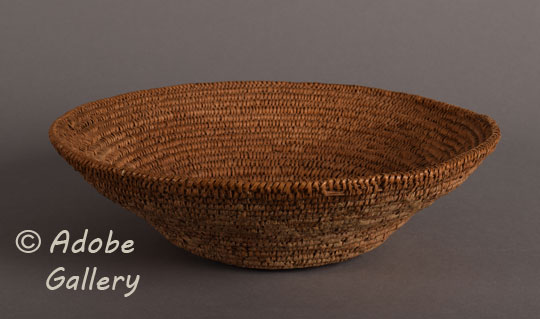Traditional Navajo Utilitarian Basket with Significant Cornmeal Residue
+ Add to my watchlist Forward to Friend
Forward to Friend
- Category: Bowls and Other Forms
- Origin: Diné of the Navajo Nation
- Medium: sumac, yucca
- Size: 3-½” deep x 11-¼” diameter
- Item # C4644L
- Price: $1050
This very old sumac and yucca basket is typical of late nineteenth-century baskets that were made for use in Diné of the Navajo Nation ceremonial functions. There is very faint visual evidence that it previously had a pattern executed in black and red, but it has faded from age and use.
What is unusual about this basket is the significant amount of cornmeal pressed against the basket on the exterior wall and bottom. There is no cornmeal residue on the interior. This is an indication that it was used for ceremonial purposes.
Diné baskets or Ts'aa' have many uses. They are used ceremonially to hold prayer sticks and medicine bundles, because it is taboo for ritual objects to touch the ground. They are important for Kinaalda' ceremonies, the coming-of-age ceremony for young women at puberty, where they are used to hold yucca suds for ritual baths and hair washing of the young woman. They are used in wedding ceremonies to hold corn pollen and food.
"The most distinctive feature of old baskets with traditional designs is their construction: coil foundations of two sumac rods topped with a hank or twist of yucca fibers. The walls of these baskets are smoother and thinner than those made with three bunched rods. They are also slightly flexible and less suitable as drums. . ." [Whiteford 1988:38]
In 1930, it was published that "the Navajo represent the only Southwestern group to manufacture two-rod and bundle coiled basketry. There seems to be little room for doubt that the Navajo took over this trait from the earlier inhabitants of the Pueblo plateau after they arrived in approximately their present position. The trait seems not to have been reported outside the Southwest, and the probability that the Navajo invented this basketry type in an area in which it had been manufactured since early times seems unlikely. [ibid]
By the end of the nineteenth century, the Navajos were making very few two-rod and bundle coiled baskets with traditional designs. They were, by then, acquiring baskets from the Utes and Southern Paiutes who were making them to relieve the Navajo women from their imposed taboos during basket-making times. Almost all twentieth century Navajo ceremonial baskets were made by the Utes and Paiutes.
Condition: good condition for its age
Provenance: this Traditional Navajo Utilitarian Basket with Significant Cornmeal Residue is from the collection of an Adobe Gallery client
Reference: Southwestern Indian Baskets - Their History and Their Makers by Andrew Hunter Whiteford, School of American Research Press, Santa Fe. 1988.
TAGS: Native American Baskets, Diné of the Navajo Nation

- Category: Bowls and Other Forms
- Origin: Diné of the Navajo Nation
- Medium: sumac, yucca
- Size: 3-½” deep x 11-¼” diameter
- Item # C4644L
- Price: $1050
Adobe Gallery Recommended Reading
Adobe Gallery Recommended Items
If you are interested in this item, we would also like to recommend these other related items:



